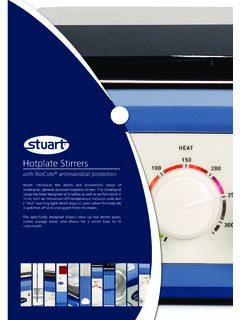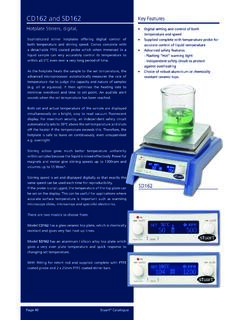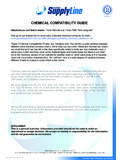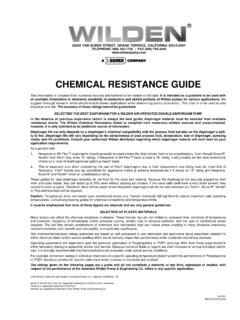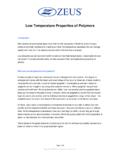Transcription of T13-001A BT50 BT30 chemical resistance - Stuart Equipment
1 +44 (0)1785 810433 bt50 and bt30 Technical Note: T13-001 bt50 and bt30 chemical resistance chart at 20 C Introduction Liquids dispensed with the bt50 and bt30 digital burettes will be in contact, constantly, with the following materials: Borosilicate glass, (BSG), PTFE, PVDF, FEP, Alumina Ceramic (AC) and Platinum Iridium (PI). The following table is a guide to help with the queries regarding liquid compatibility. Please note that these tables are just a guide. We recommend that if there is a question regarding liquid compatibility you should exercise caution in use and refer to other chemical tables where available.
2 Good laboratory practice would be to rinse out the liquid handling unit at the end of each day with distilled water to prevent corrosive liquids being left in contact with the parts for too long. chemical compatibility chemical BSG PTFE PVDF FEP AC PI Acids Acetic, glacial R VR R R Acetic, 25% R R R R R R Hydrochloric, concentrated R R VR* R1 Hydrochloric, 25% R R R R R* R Sulphuric, concentrated R R VR* VR2 Sulphuric, 25% R R R R R* R Nitric, concentrated R VR VR* VR3 Nitric, 25% R R R R Phosphoric, 25% R R R R R VR4 Formic, 25% R R R R R Trichloroacetic, 10% R R NR R R Formic acid, 85% R R R R R Arsenic acid R R R No data Boric acid, 10% R R R R R No data Chromic acid, 20% R R R R R No data Hydrofluoric acid.
3 35% NR Exceptions R R NR R Phosphoric acid 85% R R R R NR VR4 Nitric acid, 50% R R R R R R Sulphuric acid, 95% R R R R R VR2 Alkalis Ammonium hydroxide, 25% R R VR R R R Sodium hydroxide R R NR R R R Potassium hydroxide R R NR R VR VR5 Sodium hydroxide R R NR R VR VR6 Alcohols Methanol, 98% R R R R R Ethanol, 98% R R R R Ethanol, 70% R R R R Isopropanol, n-Propanol R R R R Amyl alcohol, Butanol R R R Benzyl alcohol R R R R R Ethylene glycol R R R R R Propylene glycol R R R R R Glycerol R R R R R +44 (0)1785 810433 Hydrocarbons Hexane, Xylene R R R R R Toluene, Benzene R R R R R Kerosene, Gasoline R R R Tetralin, Decalin R R R Halogenated Hydrocarbons Methyl chloride R R R Chloroform R R R R R Trichloroethylene R R R R R R Monochlorobenzene.
4 Freon R R R Carbon tetrachloride R R R R R Ketones Acetone R R NR R R Methyl ethyl ketone R R NR R Isopropylacetone R NR R Methyl isobutyl ketone R VR R Esters Ethyl acetate R R R R Methyl acetate R R R Amyl and Propyl acetate R R R Butyl acetate R R R R R Propylene glycol acetate R R R 2-Ethoxyethyl acetate R R R Methyl cellosolve acetate R R R Benzyl benzoate R R R Isopropyl myristate R R Tricresyl phosphate R VR R Oxides Ethers Ethyl ether R R R 1,4 Dioxane and Tetrahydrofuran R R VR R R Dimethylsulphoxide (DMSO) R R NR R R Isopropyl ether R R R Solvents with Nitrogen Dimethyl formamide R R NR R R Diethylacetamide R R NR R Triethanolamine R VR R Aniline R R R R R Pyridine R R VR R R R Miscellaneous Phenol, aqueous, 10% R R R R Formaldehyde solution, 30% R R R R R Hydrogen peroxide, 30% R R R R R R7 Silicone oil and Mineral oil R R R Pyridine R R VR R R R Acetaldehyde R R NR R R Ammonia, 25% ac.
5 Sol. R R NR R R8 Ammonium R NR R Calcium chloride aq. Sol R R R R R R Chlorine R R R R R R9 Chlorobenzene R R R Fluorinated hydrocarbons R R VR Hexane R R R R +44 (0)1785 810433 Iodine (tincture of) R R R R Potassium chloride aq. Sol. R R R Potassium permanganate aq. Sol. R R R10 Magnesium chloride aq. Sol. R R R Methylene chloride R R R R R Sodium carbonate R R VR11 Sodium dichromate R R R R No data Phenol, 100% R R R R R Mercury R R R R R+ NR12 Silver nitrate R R R R R R13 Toluene R R R R R Hydrogen peroxide, 30% R R R R R R7 Xylene R R R R R Zinc chloride, 10% R R R R R R Zinc sulphate, 10% R R R R R R Key: R = Resistant VR = Virtually resistant SR = Slightly resistant NR = Non-resistant Exceptions = Resistant with exceptions Notes.
6 * Depends on temperature + Up to 300 C Notes on the resistance of Platinum-Iridium The literature indicated that Aqua-Regia (3 parts hydrochloric acid: 1 part nitric acid) will cause slight attack to 10% iridium platinum. In practice, alloys containing more than 3% iridium show a great resistance to attack, unless they are in the form of a very fine powder. This usually involves the fusion of the alloy with zinc to increase the surface area. Notes 1. Hydrochloric acid in the presence of oxidising may cause slight attack on prolonged boiling.
7 2. Sulphuric acid will dull the surface with prolonged heating at above 250 C. 3. Nitric acid (fuming) may dull the surface with prolonged heating. 4. Phosphoric acid may dull the surface with prolonged heating. 5. Potassium hydroxide the fused salt will cause slight attack. 6. Sodium hydroxide the fused salt will cause slight attack. 7. Hydrogen peroxide 30% - in the presence of hydrochloric acid may cause slight attack on prolonged boiling. 8. Ammonia heating in an ammonia atmosphere will darken and dull the surface, leading to a porous crystalline appearance.
8 9. Chlorine in the presence of hydrochloric acid may cause slight attack on prolonged boiling. +44 (0)1785 810433 10. Potassium permanganate in the presence of hydrochloric acid may cause slight attack on prolonged boiling. 11. Sodium carbonate the fused salt may cause slight attack. 12. Mercury will readily attack at any temperature. 13. Silver nitrate the fused salt may cause slight attack and discolour the surface. 14. Organic compounds there is no data available on most of the organic compounds listed, it is unlikely they would have any detrimental effect but we can give no guarantee to this statement.
9
